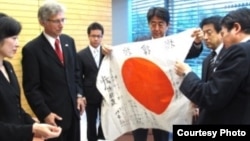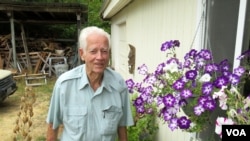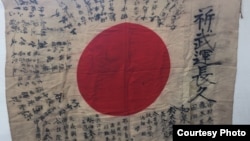People in Japan - and around the world - lit peace lanterns this past week to mark the 70th anniversary of the dropping of atomic bombs on Hiroshima and Nagasaki. More ceremonies lie ahead to mark the Japanese surrender.
Commemorations, of course, can be large or small. Six U.S. World War II veterans flew to Tokyo this month carrying 70 captured flags to return for the 70th anniversary of the end of the war. By all accounts, it was a personal journey aiming to promote healing and reconciliation.
Seventy years after he last set foot in Japan during World War II, retired American chiropractor Dallas Britt, now 89, was back to return something that didn't belong to him: a flag.
"This flag was taken off of a dead soldier, just happened to be a souvenir to be picked up," Britt said. "It has a red rising sun in the middle of it. Then it has all this Japanese writing all around it."
During the war, many soldiers collected mementos from the battlefield, especially flags. The war prize was so common these banners have an English name, “good luck flag.”
For the Japanese soldiers, the flags were often a personal item, a traditional send-off gift from family or coworkers. The Japanese name for "good luck flag" is yosegaki hinomaru, which literally translated means “group-written flag.”
Britt took the flag during a 1945 battle that ousted the Japanese from the small island of Ie Shima, near Okinawa. He said he did not understand until this summer the significance the flag might hold for the fallen soldier's family.
"It is like if you found a dead G.I. and taking his dog tags [ID tags] off of him and being able to send it back to his parents," Britt said. "That's the only connection they would have because you wouldn't know where he was buried or nothing else. What a wonderful thing to be able to return it to these people and get it back to their relatives," Britt said.
A journey to promote healing
A relatively new humanitarian nonprofit conceived this mission to mark the 70th anniversary of the end of the war. Rex and Keiko Ziak, the Japanese-American couple who founded Obon 2015, gathered 70 flags from aging veterans or their children around the U.S. Rex Ziak says they could've just mailed the flags to a Japanese ministry, but concluded hand delivery by former combatants would send a more powerful message.
"We thought, 'When in history has there ever been a time when soldiers who were fighting against an enemy return 70 years later with items that were taken from the battlefield as souvenirs showing I captured and dominated this enemy?' And now they are being returned with the sentiment of, ‘Here, we hope this brings closure.’"
Britt was joined on the repatriation mission by five other World War II combat veterans. Ed Johann of Lincoln City, Oregon, who survived the 1941 surprise Japanese attack on the U.S. base in Hawaii, says the group traveled in the spirit of reconciliation. "I have no animosity towards any of those people. Their military and our military were just following orders. We had no say-so. Our feelings didn't matter."
A formal repatriation
None other than the prime minister of Japan, Shinzo Abe, personally accepted the returned flags at a carefully choreographed ceremony in his office. A phalanx of photographers snapped away and filmed as the Ziaks and two of the aging veterans delivered the “war souvenirs" in white boxes. Prime Minister Abe and Rex Ziak both spoke about finding peace, friendship and closure. The photographers were ushered out.
Then Abe unfurled the one silk flag that was presented to him unpacked - the one Dallas Britt plucked from the battlefield so long ago. Abe closely examined the messages and names written on it. Those inscriptions will provide clues to track down relatives or descendants of the fallen soldier who had carried it into battle. Abe noticed the soldier's son and daughter wrote on the good luck flag. Their father never returned from battle. Seven decades later, a trace of him could arrive home out of the blue.
Video of the ceremony can be viewed on Japan's Government Internet TV.



